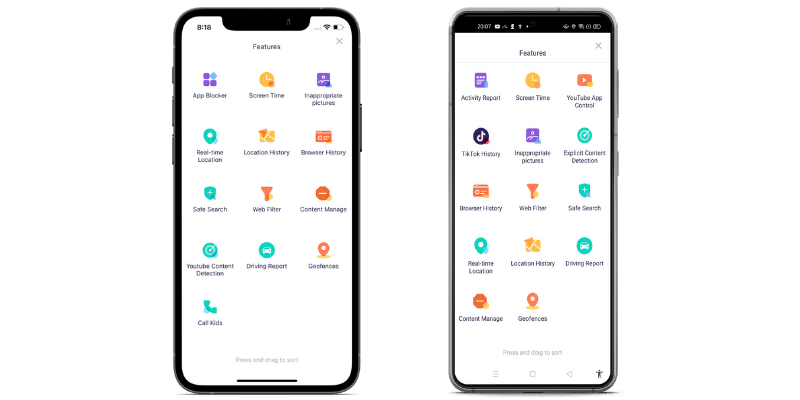Common Types of Bullying That Everyone Should Know
Different Types of Bullying
ALL TOPICS
- Anti Bullying
- Anti-Bullying Tips
- Parenting Tips
Sep 11, 2024 Filed to: Anti Bullying Proven solutions
Cruel taunts, name-calling, cyberbullying, and physical bullying – these scenarios can be commonly seen around the school campus. Bullying, be it of any kind, has become a serious problem among kids. According to a study, 28% of the US students in grade 6-12 have experienced bullying.
So, if you are a parent of a young teen, you need to pay close attention to your kid’s behavior to see if he’s doing well at school. Ignoring this problem can lead to serious issues, as bullying can be devastating for your kid’s self-esteem and confidence.
Here, in this article, we’ll take you through different types of bullying and how you can prevent your kids from internet bullying.

What are the Different Types Of Bullying?
1. Physical Bullying
This is the most obvious type of bullying and consists of hitting, kicking, punching, tripping, and physical attacks. Physical bullying can cause both long-term and short-term damage to our kids' mental and physical health. It also includes intimidating another person or stealing or damaging their belongings.
2. Verbal bullying
Verbal bullying consists of insults, calling names, racist remarks, and verbal abuse. It also includes making threats. Although this type of bullying can start harmless, it can escalate to extreme levels where it starts affecting the target kids.
Insulting someone about their physical characteristics like their height or weight or attributes such as sexuality, race, religion, or culture also constitutes physical bullying.
3. Cyberbullying
Cyberbullying has become the most common type of bullying. This term refers to a hurtful behavior that occurs through digital technologies. Cyberbullying involves bullying someone by spreading lies, mean words, and false rumors through text messages, emails, and social media posts. Cyberbullying is of different types. We have listed some typical types of cyberbullying for you.
- Denigration: Spreading online rumors and statements that are harmful, untrue, or harmful could damage an individual's reputation.
- Exclusion: The voluntary exclusion of a person from an online group is considered an indirect form of cyberbullying.
- Inflammation: The fight of sending angry, cruel, rude, and vulgar messages to one or more individuals in a private or public online environment.
- Happy Slapping: Physically attack a person as a "joke" while others film the attack or take pictures for broadcast or online display.
- Harassment: Sending a continuous series of hurtful and insulting online messages to a person.
- Identity theft: Sending or posting material online after stealing someone’s identity with the intention of damaging a person's reputation.
- Output: Sending or posting online documents (such as messages and images) to a person containing sensitive, confidential, or embarrassing information.
- Text Wars / Attacks: Track down a targeted person with a large number of text messages and average emails.
- Trickery: Engage in deception to acquire embarrassing material that is then made public online.
4. Sexual bullying
This consists of abusive comments and unwanted physical contact. Examples of this bullying include vulgar gestures, sexual name-calling, and pornographic material. Making sexist jokes, making someone feel uncomfortable because of sex, or making crude comments about one’s sexual behavior are also a type of sexual bullying.
5. Social bullying
Social bullying includes spreading rumors, negative physical gestures, playing nasty jokes to humiliate someone, encouraging others to exclude someone socially, and affecting someone’s social reputation.
6. Extortion Bullying
In this type of bullying, the bully threatens a victim if they do not do what he says. The victim may be forced to give money to the bully, lunch, or even possessions.
How can parents help their kids to handle different types of bullying?
As we have discussed above, bullying has several different types, and all of them can cause serious damage to our kids. As parents, there are things that we can do to help our kids handle bullying.
- Let kids know that you are there to support them. Most teens are afraid to fight back against bullying as they are afraid that no one would trust what they say or be there to support them. Never let your teens feel this way. Talk to them regularly and ensure them that they would always get your support.
- Stay connected with schools: As bullying like social bullying, extortion bullying, physical bullying often occur at schools. It is recommended that parents should stay connected with schools to get the updated information about how their kids are doing at school.
- Keep eyes on your teen's behaviour: If your teenage children have been bullied, they may become withdrawn and prefer to be left alone. If they have been bullied physically, you may also notice bruises on their bodies. Keep close eyes on them to take action immediately.
- Seek help from other sources: Everyone has its limits. If you are not sure whether your kids are being bullied or are having difficulties with helping your kids fight against bullying, you can look for help from other sources like the local community or experts.
How to Prevent Internet Bullying Using FamiSafe
Internet bullying has become a serious and common form of bullying nowadays. Yes, bullying has been around for some time now, but technology has given a new platform to the bullies. In this digital age, we don’t know what’s on our kid’s phone and if they’re a victim of cyberbullying.
However, cyberbullying can have serious consequences for teens. Sometimes, as parents, we don’t know how to deal with it and how and when to step in. For instance, the parents don’t know whether their kids are playing games, chatting with someone, or being on social media platforms all day long.
So, how to tackle situations like this? Fortunately, there are many parental control apps that you can use to track your kids' phone usage. These apps can even let you know if your kid is a victim of cyberbullying as they provide the feature of monitoring the texts on the target device.
One such app is FamiSafe. FamiSafe is a reliable parental monitoring app that offers features such as GPS tracking, checking browsing history, monitoring apps, location tracking, etc.
- Location Tracking & Geo-fencing
- App Blocker
- Web Filtering
- Screen Time Control
- Smart Parental Control Setting
Suspicious Text Feature Can Help Parents Get Alerts Of Bullying Words
FamiSafe has launched a new function named suspicious text. With this feature, parents can set a keyword on their phones. They will then be alerted when the text on the kid’s phone contains those keywords. With this, parents can easily know if their kids are suffering from cyberbullying.

You’ll be able to see all the suspicious messages like in the image above. With this, you can easily discover if your kid is being bullied and by whom.
How To Use FamiSafe?
Once you login to your FamiSafe account, you’ll see a homepage with the current location and various notifications.
By clicking on the dashboard, you’ll come across a screen like:

Using this intuitive dashboard, you can easily track what your kid is up to. With different tabs like activity report, browser history, suspicious text, you can get to know about the browsing history, location history, suspicious texts, etc.
So, these are the different types of bullying that you should know about. Bullying can happen anytime and to anyone, and dealing with it can erode a child’s confidence.
If you think your kid is a victim, encourage him to spend time with friends who have a positive influence. Or, if he approaches you about being bullied, be supportive and talk to him about the whole issue.
You can also use the parental control app such as FamiSafe to keep a tab on your kid’s activity. With a lot of great features, this app can let you monitor the app your kid is using, track location, check browsing history, and get alerts on suspicious messages.

Thomas Jones
chief Editor